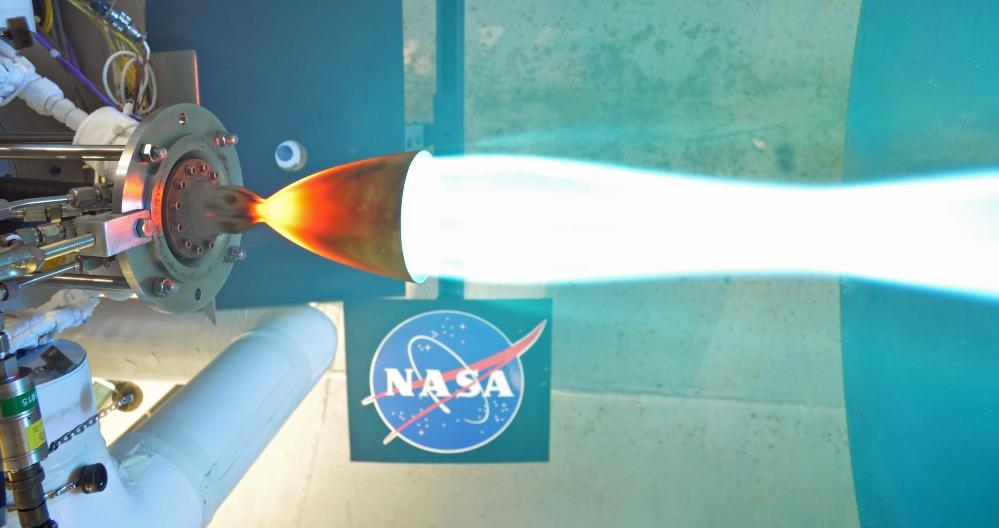- FMA
- The Fabricator
- FABTECH
- Canadian Metalworking
Our Publications
Categories
- Additive Manufacturing
- Aluminum Welding
- Arc Welding
- Assembly and Joining
- Automation and Robotics
- Bending and Forming
- Consumables
- Cutting and Weld Prep
- Electric Vehicles
- En Español
- Finishing
- Hydroforming
- Laser Cutting
- Laser Welding
- Machining
- Manufacturing Software
- Materials Handling
- Metals/Materials
- Oxyfuel Cutting
- Plasma Cutting
- Power Tools
- Punching and Other Holemaking
- Roll Forming
- Safety
- Sawing
- Shearing
- Shop Management
- Testing and Measuring
- Tube and Pipe Fabrication
- Tube and Pipe Production
- Waterjet Cutting
Industry Directory
Webcasts
Podcasts
FAB 40
Advertise
Subscribe
Account Login
Search
3D printing and thermodynamic modeling help NASA develop a high-flying alloy
Space agency’s new alloy handles temperatures above 2,000 degrees F
- May 2, 2022
- Article
- Additive Manufacturing

The GRX-810 alloy was developed to make aerospace parts used for high-temperature applications, like inside aircraft and rocket engines. Images: NASA
According to a report posted to the NASA website in April, innovators at the space agency used a 3D printing process to develop a new metal alloy that dramatically improves the strength and durability of aerospace components.
NASA calls the oxide-dispersion-strengthened alloy GRX-810 and claims the material can endure temperatures that exceed 2,000 degrees F and lasts 1,000-plus times longer than existing state-of-the-art alloys. (NASA didn’t provide specifics about GRX-810’s composition.) The new alloy is intended for aerospace parts used for high-temperature applications, like inside aircraft and rocket engines.
To develop the alloy, the researchers relied on computational models to determine its composition. The team then leveraged 3D printing to uniformly disperse nanoscale oxides throughout the alloy, which improve high-temperature properties and durability. This manufacturing process is more efficient, cost-effective, and cleaner than conventional manufacturing methods, NASA reports.
The alloy has major implications for the future of sustainable flight. For example, when used in a jet engine, the alloy’s higher temperature and increased durability translate into reduced fuel burn and lower operating and maintenance costs.
And, at 2,000 degrees F, GRX-810 provides 3.5 times the flexibility of other advanced alloys.
“Previously, an increase in tensile strength usually lowered a material’s ability to stretch and bend before breaking, which is why our new alloy is remarkable,” said Dale Hopkins, deputy project manager of NASA’s Transformational Tools and Technologies project.
When used in a jet engine, the alloy’s higher temperature and increased durability translate into reduced fuel burn and lower operating and maintenance costs.
The team applied thermodynamic modeling and leveraged 3D printing to develop the new high-temperature alloy.
Tim Smith, a materials research scientist at NASA’s Glenn Research Center in Cleveland and one of the inventors of the new alloy, said, “Applying these two processes has drastically accelerated the rate of our materials development. We can now produce new materials faster and with better performance than before.”

This turbine engine combustor (fuel-air mixer) was 3D-printed at NASA Glenn Research Center and is an example of a challenging component that can benefit from the GRX-810 alloy.
Hopkins added, “What used to take years through a trial-and-error process now takes a matter of weeks or months to make discoveries.”
Using thermodynamic modeling, one of many computational tools discussed within the NASA “2040 Vision Study,” the team discovered the optimal alloy composition after only 30 simulations.
The team applied thermodynamic modeling and leveraged 3D printing to develop the new high-temperature alloy, which drastically accelerates the rate of materials development.
The tool also eliminates dead ends by showing researchers not just what metal types to incorporate but how much of each element to infuse into the composition.
“The performance of this alloy clearly demonstrates the modeling tool’s maturity and ability to produce significant results,” said Steve Arnold, materials and structures technical discipline lead at NASA Glenn.
Click here to watch NASA’s “Additive Manufacturing Alloys for High-Temperature Applications” webinar.
About the Publication
- Podcasting
- Podcast:
- The Fabricator Podcast
- Published:
- 04/16/2024
- Running Time:
- 63:29
In this episode of The Fabricator Podcast, Caleb Chamberlain, co-founder and CEO of OSH Cut, discusses his company’s...
- Trending Articles
- Industry Events
16th Annual Safety Conference
- April 30 - May 1, 2024
- Elgin,
Pipe and Tube Conference
- May 21 - 22, 2024
- Omaha, NE
World-Class Roll Forming Workshop
- June 5 - 6, 2024
- Louisville, KY
Advanced Laser Application Workshop
- June 25 - 27, 2024
- Novi, MI


























